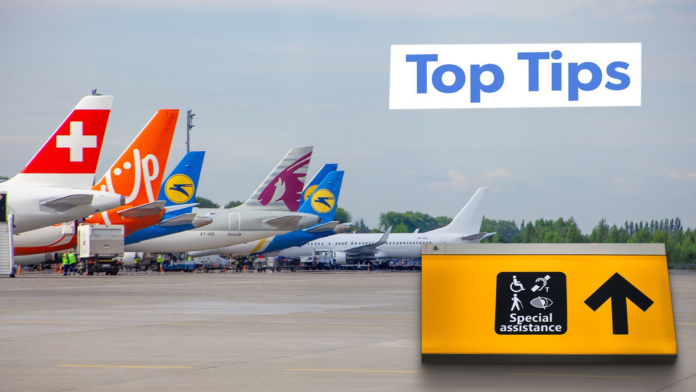Flying with a disability can come with some challenges, but the aviation industry is continuing to evolve and become more inclusive. Today, many people with disabilities do not let air travel keep them from exploring the world, working, or taking necessary trips. Airlines have several initiatives and accommodations to provide the most comfortable and stress-free experience for passengers with disabilities. Those who are deaf or have hearing loss, specifically, can further enhance their experience if they prepare beforehand.
Hearing aids undoubtedly assist people who are hard of hearing. However, there are some things to keep in mind when flying with them. In addition, allowing yourself extra time at the airport, as with everyone else, can contribute to a smooth airport experience, which can be especially busy during peak travel periods. The flight crew is also available and trained for any necessary assistance.
Thanks to today’s innovations, many might not know exactly how many people fly comfortably with hearing loss. Here are just five tips to keep in mind:
1 Pack hearing aid batteries
Keeping them in the carry-on bag
As many may know, passengers are allowed to travel with hearing aids onboard. Whether it is a two-day trip or a two-week-long vacation, it is essential to bring batteries for the hearing aids. According to hearingaid.org.uk, hearing aid batteries are permitted in carry-on bags. In fact, it is much more encouraged to bring them onboard as opposed to packing them in checked luggage. Other suggestions include:
Keep hearing aid batteries in their original packaging
Airport security will be able to identify them more easily, making the screening process smoother
Hearing aid batteries may also be kept in a clear, resealable bag
Image: Qantas
When traveling internationally, some hearing aids differ from country to country. Doing research on an airline or airport’s specific regulations and procedures may be a good idea, as rules vary depending on the destination.
2 Download your airline’s app
Most carriers have them, and they are free
In such a technological and digital age, finding an airline’s smartphone app is essential for any traveler. For deaf passengers or those who have hearing loss, the app can provide necessary details about their flight at their fingertips. Push notifications can alert the passenger of any changes, such as:
Delays
Cancelations
Gate changes
Checked baggage delays or carousel changes
Photo: Rido | Shutterstock
As many of these changes may be delivered verbally, the app notifies passengers with hearing loss of the same information. It allows travelers to be self-sufficient and to save time, as they would not need to wait in a potentially long customer service line to have their questions answered.
Photo: David Tran Photo | Shutterstock
Airline apps also have mobile boarding passes, meaning travelers do not need to seek a ticketing agent to provide them with a printed boarding pass. This can especially speed up the check-in process if passengers are not traveling with any checked bags. Since the app is digitally updated, any changes to a departure gate will be automatically reflected on the boarding pass.
Another app that passengers with hearing loss can download is the Signlive app. According to hearingaid.org.uk, Signlive is a 24-hour online video-interpreting service that allows deaf passengers to communicate with airport staff. The app connects them to a qualified British Sign Language (BSL) interpreter within seconds.
3 Airline accessibility & special assistance accommodations
Learn about the specifics before arriving at the airport
Every airline offers specific accessibility accommodations and special assistance to passengers with disabilities. Before arriving at the airport, it is important to research each carrier’s accommodations. This allows travelers to be prepared when it is time to check in or board their flight. Virgin Atlantic, for example, has an entire webpage dedicated to the assistance it offers for deaf or hard-of-hearing passengers. Some of the details about its accommodations include:
Airport maps and guide pages
Escorted travel
Online check-in
Traveling with assistance dogs
Seat orientation
Accessible inflight entertainment (IFE)
How to contact their Special Assistance team
Photo: Vincenzo Pace | Simple Flying
Virgin Atlantic also notably has a hidden disability symbol, which discreetly informs staff if a passenger might need assistance. The passenger can show the symbol to anyone in a Virgin Atlantic uniform at any point throughout their journey. The symbol can be downloaded on the carrier’s website and be displayed digitally. It can also be picked up at check-in.
4 Inquire about priority boarding
Some airlines may provide it
When arriving at the gate, passengers with hearing loss can consult the gate agent to inquire about possibly being among the first to board. According to British Deaf News, it can be a challenge to understand what the agent may be announcing on the PA system as a flight nears its boarding time. As such, getting to the gate early and conversing with the agent beforehand could be helpful.
Photo: Raleigh–Durham International Airport
Virgin Atlantic allows disabled passengers to come forward during the boarding process if they need more time to settle in. The airline also provides:
Wheelchair assistance
Wheelchair stowage
Assistance with stowing cabin baggage
5 Informing the crew
Help them help you
Attempting to travel with hearing loss but without informing the crew could potentially make things more complicated than they need to be. Although flight attendants’ primary concern is passengers’ safety, comfort is also an important aspect, especially if a passenger has never flown before or is a nervous flyer. Telling the crew of any disability can set the passenger and crew up for success.
Photo: Air New Zealand
Depending on the airline, travelers could also inform their carrier of their disability well in advance of their flight:




